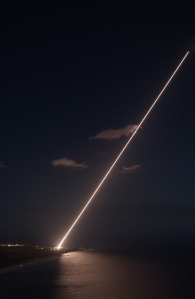 Missile interceptor test lights up the night sky
Missile interceptor test lights up the night sky
By Tom Z. Collina
In its own multi-million dollar display of fireworks, the U.S. Missile Defense Agency (MDA) will conduct an intercept test of the Ground-Based Interceptor (GBI) system on Friday, July 5. This will be the first test of the system's ability to hit a mock target since two failures in 2010. The last successful intercept was in 2008.
However, this is not the key test that will determine if the Pentagon can go ahead with its $1 billion-plan to field 14 additional GBIs in Alaska by 2017, as announced by Defense Secretary Hagel in March. That test is planned for late 2013.
Confused?
Here's the deal: there are currently 30 GBI missiles deployed in Alaska and California, armed with two different "kill vehicles" --which is the thing that sits on top of the GBI missile and is supposed to collide with an incoming warhead in space.
CE-I: Twenty (20) of these GBIs are armed with "Capability Enhancement-I" (CE-I) kill vehicles, which were fielded from 2004 to 2007. The CE-I has not been tested since December 2008, and it is this kill vehicle that will be tested on Friday. The CE-I has a success rate of about 50 percent, so this is kind of a let's-make-sure-it-still-sometimes-works test.
CE-II: Ten (10) GBIs are armed with the newer CE-II, fielded in 2008 but not used in an intercept test until January and December 2010; both tests failed. (Yes, there is a reason to fly before you buy.) As a result, MDA suspended additional CE-II deployments and said that fielded GBI missiles armed with CE-IIs would not be considered operational until a successful intercept test, which has yet to take place. MDA later found a flaw in the guidance system of the Raytheon-made CE-II.
Acknowledging the GBI system's shortcomings, Hagel said in March that he would not deploy the additional 14 interceptors with CE-IIs "until we are sure that we have the complete confidence that we will need." James Miller, the undersecretary of defense for policy, said the Pentagon would "stick with our fly-before-you-buy approach," noting that the CE-II had "a couple of test failures" in 2010.
Miller said that if the CE-II test is successful, the Pentagon would "make changes to those CE-IIs that are currently in place, and then the new ground-based interceptors would also be [outfitted with] CE-IIs."
Even if the next intercept tests are successful against simple, intermediate-range targets, they are not expected to test the system's effectiveness against ICBM threats or countermeasures such as decoys. The GAO has said that the capability of the two kill vehicles against decoys "has not been validated" and that tests against ICBMs will not occur until 2015 or later.
As Pentagon Director of Operational Testing Michael Gilmore testified May 9, "If we can't discriminate what the real threatening objects are, it doesn't matter how many ground-based interceptors we have; we won't be able to hit what needs to be hit."
Bottom line: Friday's test is to confirm that the older CE-I kill vehicle still "works" some of the time against simple, staged targets, but it will not tell us if the planned expansion from 30 to 44 GBIs can go forward. We wont know that until the CE-II test later this year.
